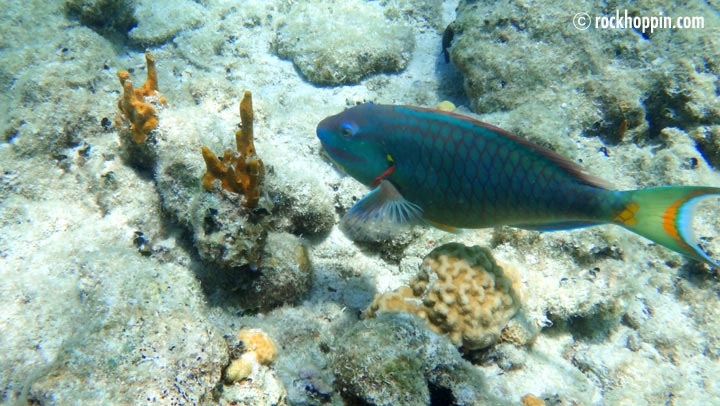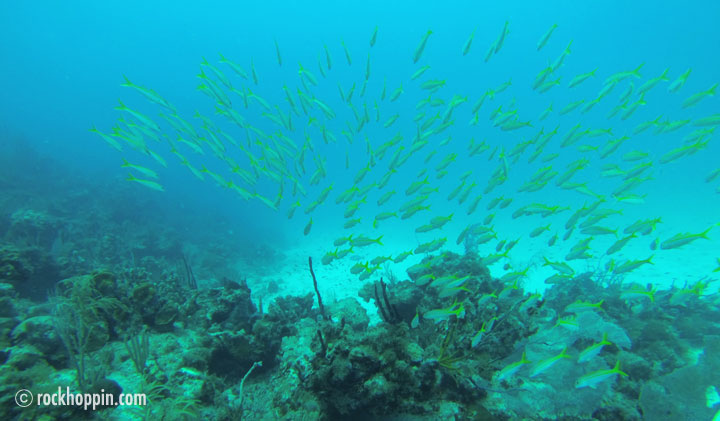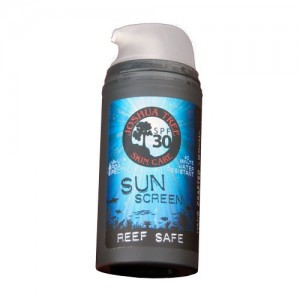Snorkeling the waters of St. John, USVI is one of the most rewarding and fun things to do on St. John, it’s cheap and easily accessible for anyone, the water is warm and usually calm. You can see Angel Fish, Parrot Fish, Seargent Majors, Yellow Tail Snapper, Puffer Fish to name a few and of course Sea Turtles.
Snorkeling Basics:
The key to snorkeling fun is having a well-fitting mask that does not leak and does not fog. Try on the mask without the strap and suck it to your face. Does it hold by itself? Then the mask has the right size. Don’t be shy of trying on many different masks to find the perfect one! You can tighten the strap as much as you want, it will only give you a headache but not stop an ill-fitting mask from leaking. To keep the mask from fogging, spit into it, use your fingers to swipe it completely over the mask (from the inside) and then rinse a little. Sounds yucky, but this is seriously the best way to keep it from fogging. Something to do with chemicals in the salvia. Don’t breath out through your nose, that will make the mask fog! If you have never breathed through a snorkel, don’t be shy of practicing this in the pool first! Also, you might start snorkeling without fins first to focus on practicing how to breath. If you are snorkeling off a boat, drop in backwards! When swimming with fins, make sure there are under water! Kicking above the water will not get you anywhere, it is just a waste of energy! Check out this nicely illustrated Wikihow on Snorkeling Basics.
Snorkeling Rules & Hints:
- Never touch anything! Sea Urchins and certain corals can sting badly. Also beware of Cone Shells, they can sting as well ! The cone snail injects a rapid acting venom from a dart-like tooth
- Don’t Harass Sea Life – Like Fish & Turtles Give the poor critters some space. Sure you can swim slowly towards turtles and fish, but don’t try to get too close. And if they are resting, on the bottom or on shore, give them lots of space. The same goes for all sea life.
- use reef-safe sun screen. When you buy sunscreen, look at the ingredients. The main components of most sunscreens are zinc oxide and titanium dioxide—ingredients that will never biodegrade and have the potential to harm corals and sea life. Some also contain mineral oil (petroleum) which has a low solubility rate in water, is slow to biodegrade and is known to be harmful or fatal to some aquatic life and birds.
- Never stand on anything but sand. Coral reefs are very fragile and grow extremely slow. What you destroy in a split second, will take years to replace!
- Keep staring at one particular section of a reef. You might not see much initially but the longer you look, the more you see!
- Stay Relaxed & Swim Slowly! Exhaustion is a common problem for first time snorkelers. Swimming takes a good bit of energy. The trick with snorkeling is to stay relaxed and calm. You can wipe yourself out quickly if you are not careful. Only swim at a speed that allows you to breathe slowly and easily through your snorkel. Your snorkel does limit your breath, so keep your activity level at a pace that does not demand heavy breathing. Your fins will make it much easier. Learn to just float without effort. Only swim rapidly if necessary for safety!
- Read Ocean Conditions: Understand ocean currents, waves and surge. The ocean is alive, and the water flows, often taking you with it. Understanding the basics of how the ocean moves and your place in the movement is essential for safety
Where to go Snorkeling?
Book a half-day snorkeling trip with Rockhoppin’ and Captain Steve will take you some to of the best snorkeling spots. Alternatively, you can rent a paddleboard with luggage net and paddle out e.g. to Whisling Cay.
After snorkeling:
Try to identify the fish you saw. There is a very cool website called ID Gallery which has thousands of photos of fish and underwater life.


